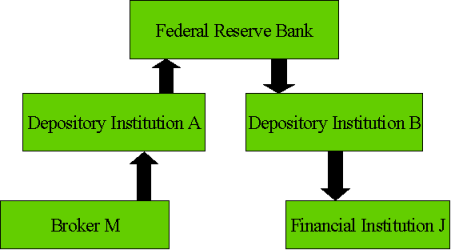Commercial Book-Entry System
The Commercial Book-Entry System (CBES) is a multitiered automated system for purchasing, holding, and transferring marketable securities. CBES exists as a delivery versus payment system that provides for the simultaneous transfer of securities against the settlement of funds.
At the top tier of CBES is the National Book-Entry System (NBES), which is operated by the Federal Reserve Banks. For Treasury securities, the Federal Reserve operates NBES in their capacity as the fiscal agent of the U.S. Treasury. The Federal Reserve Banks maintain book-entry accounts for depository institutions, the U.S. Treasury, foreign central banks, and most government sponsored enterprises (GSEs).
At the next tier in CBES, depository institutions hold book-entry accounts for their customers, which include brokers, dealers, institutional investors, and trusts. At the next tier, each broker, dealer, and financial institution maintains book-entry accounts for individual customers, corporations, and other entities.
When an investor purchases securities through a broker, dealer, or financial institution, the securities are held on the book-entry system of that firm. Holding Treasury securities in this manner is known as indirect holding since there is one or more entities between the investor and the issuer (U.S. Treasury).
The CBES has succeeded in replacing paper securities with electronic records, eliminating the potential for theft, loss, or counterfeiting. Securities owners receive interest and redemption payments wired directly to their linked accounts, no more clipping interest coupons or presenting certificates for redemption.
The following is a visual representation of the multilayered nature of the Commercial Book-Entry system.

Example: A customer of broker M sells a security to a customer of financial institution J.
- Broker M delivers the securities to Depository institution A by sending a message wire instructing Depository A's computer to deliver the securities to Financial Institution J.
- In turn, Depository A's computer sends the message to the Federal Reserve's book-entry computer, which debits Depository A for the security and credits Depository B's account for the security.
- Depository B's computer sends a message wire to Financial Institution J's computer to inform it of the electronic receipt of the security.
- Financial Institution J applies the security to the buyer's account.
- In turn, the Federal Reserve Bank will debit Depository B's reserve (money) account at the Fed and credit Depository Bank A's reserve account for the same amount to complete the transaction.
- The money debits and credits will follow a similar transaction path as the securities until they reach the buyer's and seller's accounts.
Programs Unique to Commercial Book-Entry
- STRIPS
- BECCS and CUBES For paper certificates you want to convert to book-entry
- Collateral Information for participants in U.S. Treasury collateral programs
Fee Schedule
- 2008 Fee Schedule
- Federal Register Details of 2008 Fee Schedule
- 2007 Fee Schedule
- Federal Register Details of 2007 Fee Schedule
